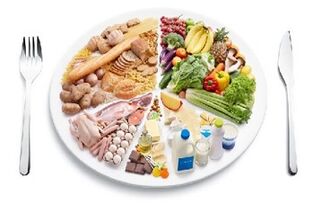
The diet for pancreatitis depends on whether the disease is acute or chronic. Remember that inflammation of the pancreas is not a trifle because it plays an important role in digestion, metabolism, and assimilation of substances (proteins, carbohydrates, and fats). Therefore, significant changes in diet should be made immediately after diagnosis. Otherwise, even the latest generation of drugs will be helpless.
Acute (reactive) pancreatitis
As the name suggests, the disease occurs suddenly (usually immediately after eating an irritating food). Symptoms: burning pain in the abdomen, fever, nausea, vomiting. Risk factors: lack of protein in the diet, overeating, alcohol consumption, smoking, fatty, spicy, fried, too cold or too hot food, fresh soda water. Sometimes the disease is a consequence of gallstone disease and chronic cholecystitis.
The feeding of pancreatitis in acute (reactive) form in adults and children is aimed at ensuring maximum rest of the pancreas for a long time, and at the same time reduces pancreatic and gastric secretions. And the sequence of patient actions should be as follows:
- The first 2-4 days after exacerbation.We recommend that you do not eat at all, but only use small amounts of medicinal mineral water in small sips and amounts.
- From day 5.Gradually and very carefully expand your diet for pancreatitis. To do this, it is recommended to follow the 5P operating table.
- for 6-7 days.Dietary jelly, slimy soups, kefir, liquid cereals (except millet), braised chicken, beef and fish slices, mashed potatoes and other vegetables cooked and steamed, weak tea, fried or crushed apples, rosehips
Diet and sample menu features
Regardless of where the patient is referred for treatment of pancreatitis - in a sanatorium or at home, you should follow a diet 5 based on the following principles:
- The daily norm for vegetable proteins - 30 g, animal proteins - 50 g, vegetable fats - 15 g, animal fats - 45 g and carbohydrates - 200 g. The total caloric intake of pancreatitis should not exceed 2500-2700 kcal per day. The amount of liquid consumed is 1, 5 liters, the salt is 10 g.
- For the first two weeks, we cook food without salt.
- Eat small portions at least 5-6 times a day to eliminate the risk of overeating.
- The temperature of cooked food should be between 45 and 60 degrees.
- The consistency of the food is liquid, semi-liquid, that is, only pureed food.
A diet for acute pancreatitis means the complete exclusion of smoked meats, fried foods, pickles, pickles, sour cream, lard, canned goods, baked goods and fresh bread, cream, alcohol from the menu for a long time (almost a year). By following the above recommendations, you can prevent the disease from developing in a chronic form! The daily sample menu should look like this:
- Breakfast:steamy omelette, water-pureed Herculean porridge, weak tea.
- Second breakfast:cheese with milk.
- Lunch:buckwheat soup, boiled meat stew, apple jelly.
- Dinner:fish steamed slices, carrot puree, rosehip broth.
- For the night:kefir.
Chronic inflammation of the pancreas
This disease has another extremely attractive name - prediabetes. Indeed, if you have already gone through the acute stage unfavorably (in the absence of proper treatment), the next step may be diabetes mellitus. This disease is characterized by two alternating stages - exacerbation and remission. Therefore, the goal of feeding with pancreatitis is to alleviate the inflammatory process and accordingly turn the disease into a remission phase.
So from now on, the diet will be a lifelong nutrition system. And you can't do anything about it. You can still use the No. 5 diet as a basis, the principles of which we continue to adhere to. The diet associated with the exacerbation of chronic pancreatitis returns again to the first three steps (fasting with mineral water and further on the list above).
Approved products:
- milk, yoghurt, kefir, non-sour cottage cheese, light cheese;
- porridge (buckwheat, oats, rice), pasta;
- vegetables (potatoes, carrots, pumpkins, zucchini, beets, etc. );
- wheat crackers or obsolete white bread;
- meat (veal, chicken, rabbit, turkey), lean fish;
- baked apples, fruit jelly, berries;
- oatmeal, fruit drink, non-acidic juices, chamomile tea;
- vegetable soups and puree soups, celery juice.
Prohibited Products:
- sour fruits, fresh cabbage, legumes;
- spinach, sorrel, radish, radish;
- hot spices and herbs;
- fresh bread, cakes, sweets;
- sausages, smoked meat, canned food, eggs;
- meat, fish soup, cabbage soup, borscht;
- alcohol, sweet drinks with gas;
- sweets, ice cream, sour cream, cream;
- fried foods.






























